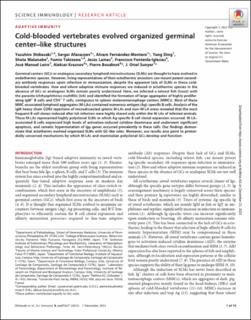| dc.contributor.author | Shibasaki, Yasuhiro | |
| dc.contributor.author | Afanasyev, Sergey | |
| dc.contributor.author | Fernández-Montero, Alvaro | |
| dc.contributor.author | Ding, Yang | |
| dc.contributor.author | Watanabe, Shota | |
| dc.contributor.author | Takizawa, Fumio | |
| dc.contributor.author | Lamas, Jesús | |
| dc.contributor.author | Fontenla-Iglesias, Francisco | |
| dc.contributor.author | Leiro, José Manuel | |
| dc.contributor.author | Krasnov, Aleksei | |
| dc.contributor.author | Boudinot, Pierre | |
| dc.contributor.author | Sunyer, J Oriol | |
| dc.date.accessioned | 2023-12-23T11:56:44Z | |
| dc.date.available | 2023-12-23T11:56:44Z | |
| dc.date.created | 2023-12-18T12:18:14Z | |
| dc.date.issued | 2023 | |
| dc.identifier.citation | Science immunology. 2023, 8 (90), 1-15. | |
| dc.identifier.issn | 2470-9468 | |
| dc.identifier.uri | https://hdl.handle.net/11250/3108839 | |
| dc.description.abstract | Germinal centers (GCs) or analogous secondary lymphoid microstructures (SLMs) are thought to have evolved in endothermic species. However, living representatives of their ectothermic ancestors can mount potent secondary antibody responses upon infection or immunization, despite the apparent lack of SLMs in these cold-blooded vertebrates. How and where adaptive immune responses are induced in ectothermic species in the absence of GCs or analogous SLMs remain poorly understood. Here, we infected a teleost fish (trout) with the parasite Ichthyophthirius multifiliis (Ich) and identified the formation of large aggregates of highly proliferating IgM+ B cells and CD4+ T cells, contiguous to splenic melanomacrophage centers (MMCs). Most of these MMC-associated lymphoid aggregates (M-LAs) contained numerous antigen (Ag)–specific B cells. Analysis of the IgM heavy chain CDR3 repertoire of microdissected splenic M-LAs and non–M-LA areas revealed that the most frequent B cell clones induced after Ich infection were highly shared only within the M-LAs of infected animals. These M-LAs represented highly polyclonal SLMs in which Ag-specific B cell clonal expansion occurred. M-LA–associated B cells expressed high levels of activation-induced cytidine deaminase and underwent significant apoptosis, and somatic hypermutation of Igμ genes occurred prevalently in these cells. Our findings demonstrate that ectotherms evolved organized SLMs with GC-like roles. Moreover, our results also point to primordially conserved mechanisms by which M-LAs and mammalian polyclonal GCs develop and function. | |
| dc.language.iso | eng | |
| dc.title | Cold-blooded vertebrates evolved organized germinal center-like structures | |
| dc.title.alternative | Cold-blooded vertebrates evolved organized germinal center-like structures | |
| dc.type | Peer reviewed | |
| dc.type | Journal article | |
| dc.description.version | publishedVersion | |
| dc.source.pagenumber | 1-15 | |
| dc.source.volume | 8 | |
| dc.source.journal | Science immunology | |
| dc.source.issue | 90 | |
| dc.identifier.doi | 10.1126/sciimmunol.adf1627 | |
| dc.identifier.cristin | 2214812 | |
| cristin.ispublished | true | |
| cristin.fulltext | original | |
| cristin.qualitycode | 1 | |
